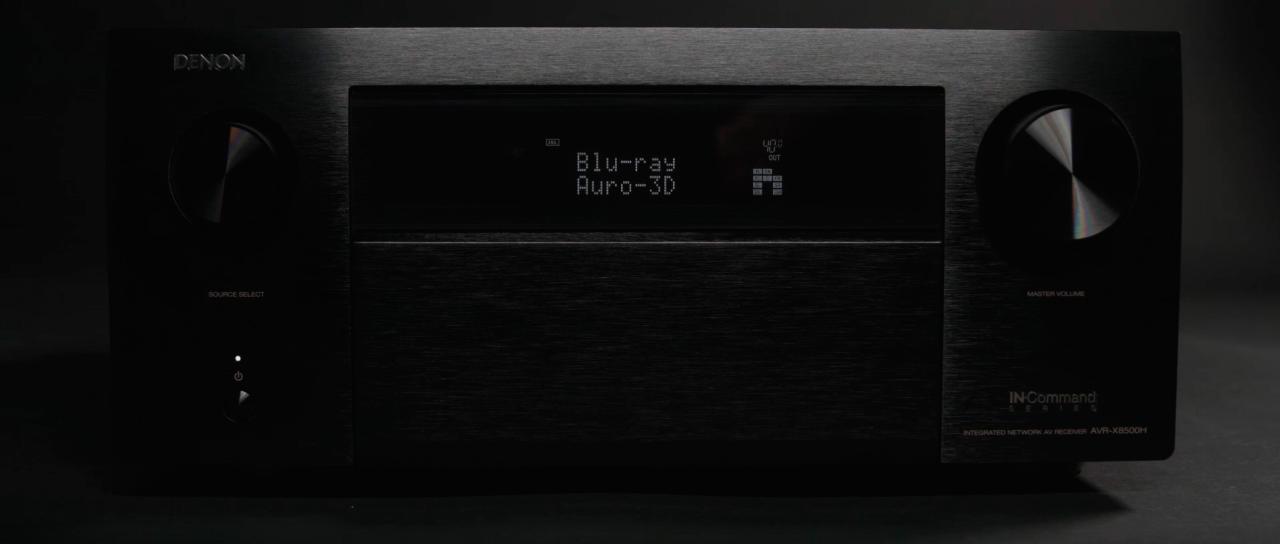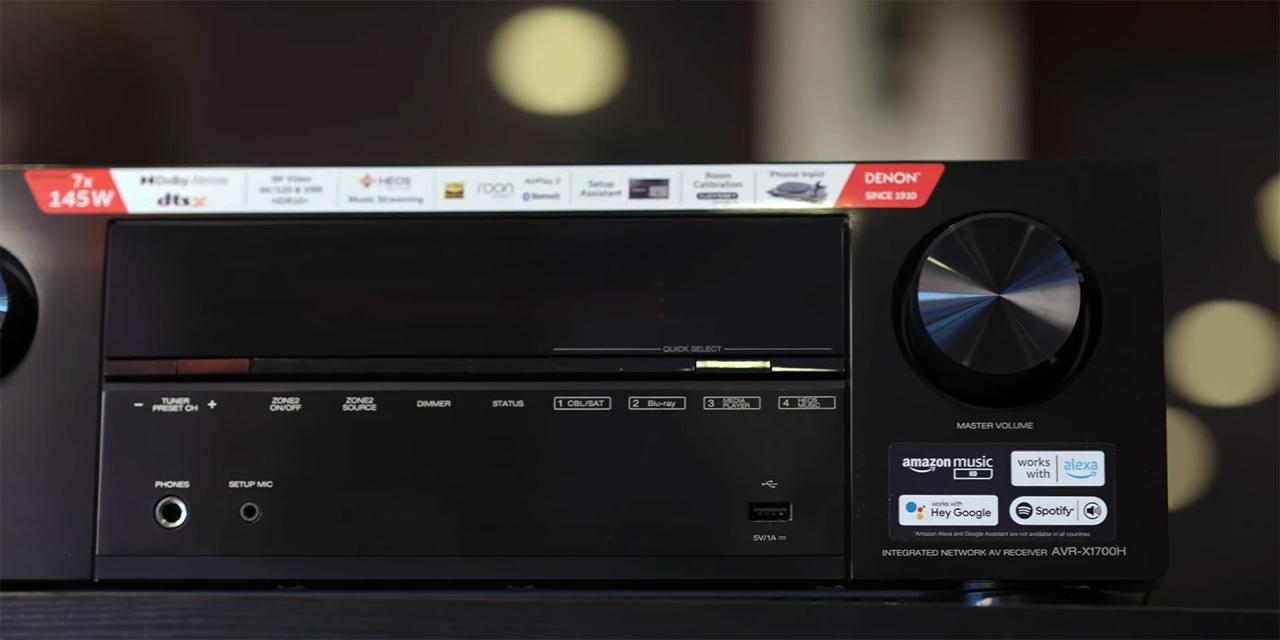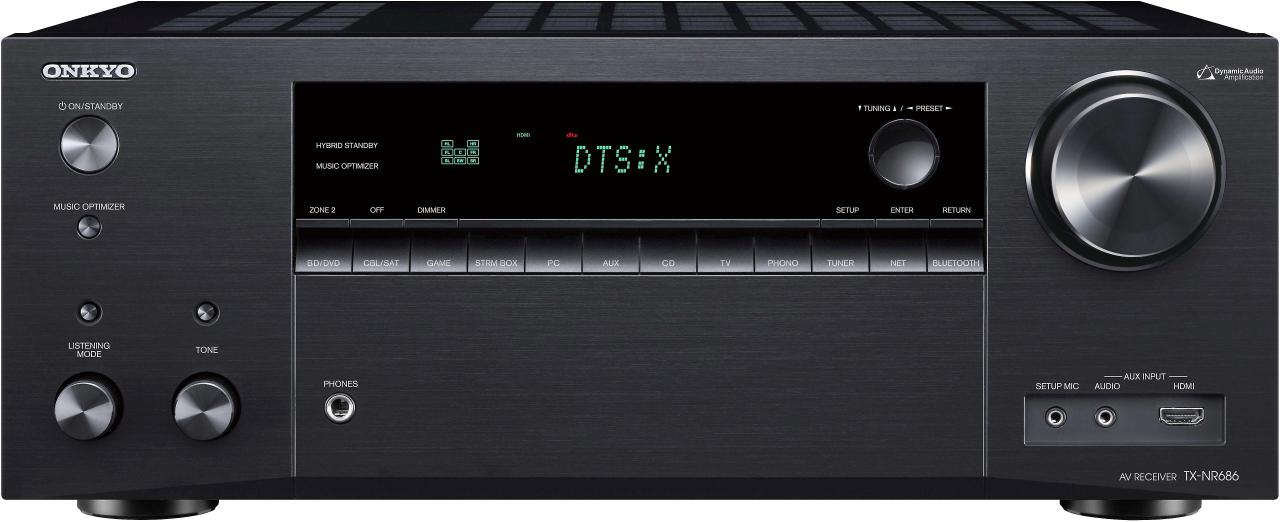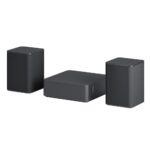With 9 Best AV Receivers for Dolby Atmos and 7.1 Surround Sound at the forefront, this paragraph opens a window to an amazing start and intrigue, inviting readers to embark on a journey through the world of advanced audio technology. From defining AV receivers to exploring the top features and future trends, get ready to dive into a realm of immersive sound experiences.
Are you ready to elevate your home entertainment setup to new heights? Let’s explore the best AV receivers that bring Dolby Atmos and 7.1 surround sound to life.
Overview of AV Receivers
AV receivers, also known as audio/video receivers, are essential components of home entertainment systems that serve as the central hub for audio and video signals. They receive audio and video signals from various sources such as Blu-ray players, gaming consoles, and cable boxes, and then process and amplify the audio signals to drive your speakers.
Key Features of AV Receivers for Dolby Atmos and 7.1 Surround Sound
When looking for AV receivers for Dolby Atmos and 7.1 surround sound setups, there are several key features to consider:
- Compatibility with Dolby Atmos: Look for AV receivers that are compatible with Dolby Atmos, a cutting-edge audio technology that provides immersive, three-dimensional sound.
- Number of channels: For a 7.1 surround sound setup, you will need an AV receiver that can support at least 7 channels plus a subwoofer channel for low-frequency effects.
- Power output: Make sure the AV receiver has enough power output to drive your speakers effectively, especially if you have large or power-hungry speakers.
- HDMI inputs and outputs: Having multiple HDMI inputs and outputs is crucial for connecting various devices such as gaming consoles, Blu-ray players, and streaming devices.
- Room calibration technology: Look for AV receivers with room calibration technology that can optimize audio performance based on the acoustics of your room.
- Network connectivity: Consider AV receivers with network connectivity options for streaming music, firmware updates, and accessing online content.
- User-friendly interface: A user-friendly interface and remote control make it easier to navigate settings and adjust audio preferences.
Top Features to Consider
When choosing an AV receiver for Dolby Atmos and 7.1 surround sound, several key features play a crucial role in delivering an immersive audio experience. These features not only enhance the sound quality but also contribute to creating a cinematic feel in your home entertainment setup.
1. Dolby Atmos Support
- One of the most important features to consider is Dolby Atmos support, which allows for object-based audio technology. This feature creates a three-dimensional sound experience by placing sound effects in specific areas of your room, making you feel like you’re right in the middle of the action.
- AV receivers with Dolby Atmos support can decode and process the audio signals to deliver a more realistic and immersive soundstage, with sound coming from all directions, including overhead.
- Having Dolby Atmos support ensures that you can take full advantage of the latest audio formats and enjoy a truly cinematic experience in your home theater.
2. Number of Channels
- The number of channels supported by an AV receiver is another crucial factor to consider. For optimal 7.1 surround sound performance, you will need a receiver that can support at least 7 channels, along with a subwoofer for low-frequency effects.
- More channels mean more audio information can be processed, resulting in a more detailed and immersive sound experience. Look for AV receivers that offer flexibility in channel configurations to suit your specific setup needs.
- Having the right number of channels ensures that each speaker in your system receives the correct audio signals, creating a seamless surround sound environment.
3. Audio Decoding and Processing
- High-quality audio decoding and processing capabilities are essential for delivering clear and accurate sound reproduction. Look for AV receivers with advanced audio codecs, such as DTS:X and Dolby TrueHD, to ensure a premium audio experience.
- These codecs enable the receiver to decode and process audio signals with precision, resulting in lifelike sound effects and dynamic range. With proper audio decoding, you can enjoy every nuance of the audio as the filmmakers intended.
- Choose an AV receiver that offers a wide range of audio processing options to customize the sound to your preferences and optimize the audio performance for different types of content.
Best AV Receivers for Dolby Atmos
When it comes to creating a truly immersive audio experience, Dolby Atmos is a game-changer. To enjoy the full potential of this technology, you need a top-quality AV receiver that can handle Dolby Atmos with ease. Here are some of the best AV receivers known for their Dolby Atmos capabilities:
1. Denon AVR-X4500H
The Denon AVR-X4500H is a powerhouse of an AV receiver that supports Dolby Atmos and DTS:X for a truly cinematic sound experience. With 9 channels of amplification and 125 watts per channel, this receiver can easily fill a large room with rich, detailed sound. It also features Audyssey MultEQ XT32 room calibration for optimal audio performance.
2. Marantz SR7013, 9 Best AV Receivers for Dolby Atmos and 7.1 Surround Sound
The Marantz SR7013 is another top-rated AV receiver that excels in delivering Dolby Atmos sound. With 9 channels of amplification and 125 watts per channel, this receiver offers exceptional audio quality and clarity. It also supports IMAX Enhanced, Dolby Vision, and Auro 3D for a truly immersive home theater experience.
3. Yamaha RX-A3080
Yamaha is known for producing high-quality audio equipment, and the RX-A3080 is no exception. This AV receiver supports Dolby Atmos and DTS:X for a thrilling surround sound experience. With 9 channels of amplification and Yamaha’s proprietary Cinema DSP technology, the RX-A3080 delivers stellar audio performance.
4. Sony STR-DN1080
The Sony STR-DN1080 is a budget-friendly AV receiver that doesn’t skimp on features. It supports Dolby Atmos and DTS:X for a dynamic audio experience. With 7 channels of amplification and Sony’s Digital Cinema Auto Calibration technology, this receiver delivers impressive sound quality at an affordable price point.
5. Onkyo TX-NR787
The Onkyo TX-NR787 is a versatile AV receiver that supports Dolby Atmos and DTS:X for a truly immersive audio experience. With 9 channels of amplification and 100 watts per channel, this receiver can handle even the most demanding audio setups. It also features AccuEQ room calibration for precise audio tuning.
6. Pioneer Elite SC-LX704
Pioneer is known for its high-end audio equipment, and the Elite SC-LX704 is a prime example. This AV receiver supports Dolby Atmos and DTS:X for a captivating surround sound experience. With 9 channels of amplification and Pioneer’s Direct Energy HD Amplification technology, the SC-LX704 delivers exceptional audio performance.
7. Anthem MRX 1120
The Anthem MRX 1120 is a premium AV receiver that offers top-notch audio quality and support for Dolby Atmos and DTS:X. With 11 channels of amplification and Anthem’s ARC room correction technology, this receiver delivers unmatched audio fidelity and precision. It’s a favorite among audiophiles and home theater enthusiasts.
8. NAD T 778
NAD is renowned for its audiophile-grade audio equipment, and the T 778 is no exception. This AV receiver supports Dolby Atmos and DTS:X for a truly immersive listening experience. With 9 channels of amplification and NAD’s Modular Design Construction, the T 778 offers exceptional sound quality and flexibility.
9. Arcam AVR850
Arcam is known for its high-end audio gear, and the AVR850 is a standout AV receiver for Dolby Atmos enthusiasts. With 7 channels of amplification and Arcam’s legendary sound quality, this receiver delivers a truly immersive audio experience. It also supports Dirac Live room correction for precise audio calibration.These AV receivers are among the best in the market when it comes to Dolby Atmos capabilities.
Whether you’re a serious audiophile or a casual movie watcher, investing in one of these receivers will take your home entertainment experience to the next level.
Best AV Receivers for 7.1 Surround Sound
When it comes to creating an immersive audio experience in your home theater, having a high-quality AV receiver that supports 7.1 surround sound is essential. These receivers are designed to deliver rich and detailed audio across multiple channels, providing a truly cinematic experience right in your living room.
Sony STR-DN1080
- The Sony STR-DN1080 is a top-of-the-line AV receiver that excels in delivering 7.1 surround sound.
- With support for Dolby Atmos and DTS:X, this receiver can create a realistic soundstage that envelops you in sound.
- Advanced Digital Cinema Auto Calibration (DCAC) technology ensures optimal audio performance in any room.
Denon AVR-X3600H
- The Denon AVR-X3600H is another excellent choice for those seeking a 7.1 surround sound setup.
- Featuring IMAX Enhanced technology, this receiver delivers powerful and precise audio across all channels.
- Support for various audio formats, including Dolby Atmos and DTS:X, ensures compatibility with a wide range of content.
Yamaha RX-A1080
- The Yamaha RX-A1080 is a versatile AV receiver that is perfect for 7.1 channel configurations.
- YPAO (Yamaha Parametric Acoustic Optimizer) technology analyzes the acoustics of your room and adjusts audio settings accordingly.
- MusicCast compatibility allows for seamless multi-room audio streaming throughout your home.
Installation and Setup Tips: 9 Best AV Receivers For Dolby Atmos And 7.1 Surround Sound
When setting up your AV receiver for Dolby Atmos and 7.1 surround sound, it’s crucial to follow a step-by-step guide to ensure optimal performance. Proper speaker placement and calibration are key factors in achieving the best audio experience. Additionally, being aware of common troubleshooting issues and how to resolve them can save you time and frustration during the setup process.
Speaker Placement and Calibration
- Start by placing your speakers according to the manufacturer’s recommendations. This typically includes front, center, surround, and overhead speakers for Dolby Atmos.
- Use a level to ensure that all speakers are positioned correctly and are at the same height for balanced sound distribution.
- Calibrate your speakers using the built-in room correction feature on your AV receiver. This will help adjust the audio output based on the acoustics of your room.
- Consider investing in a sound meter to fine-tune the speaker levels manually for precise audio balance.
Common Troubleshooting Issues
- If you experience no sound from your speakers, check the speaker connections to ensure they are properly plugged into the receiver.
- Verify that the speaker wires are not damaged or frayed, as this can affect audio output.
- If you encounter audio dropouts or distortion, check for interference from other electronic devices and move them away from your AV receiver.
- Ensure that all firmware and software updates are installed on your AV receiver to prevent compatibility issues with your audio sources.
Compatibility with Audio Devices
When setting up a home theater system with Dolby Atmos and 7.1 surround sound, it is crucial to consider the compatibility of your AV receiver with various audio devices. This ensures seamless integration and optimal performance of your audio setup.
Types of Audio Devices
- Speakers: High-quality speakers are essential for delivering immersive sound in a Dolby Atmos or 7.1 surround sound system. These speakers should be compatible with your AV receiver to ensure proper decoding and distribution of audio channels.
- Subwoofers: Subwoofers are responsible for producing low-frequency bass sounds, adding depth and realism to your audio experience. Make sure your AV receiver can support subwoofers for a complete audio setup.
- Soundbars: Soundbars are a popular choice for compact home theater setups. Check if your AV receiver can connect to a soundbar to enhance audio output.
- Amplifiers: Amplifiers can boost the power and clarity of audio signals, improving the overall sound quality. Verify that your AV receiver is compatible with amplifiers for enhanced audio performance.
Additional Accessories for Integration
- Audio Cables: High-quality audio cables are essential for connecting audio devices to your AV receiver. Opt for cables with gold-plated connectors to minimize signal loss and interference.
- Wireless Adapters: If you prefer a wireless setup, consider using wireless adapters to connect audio devices to your AV receiver. This can help reduce cable clutter and provide more flexibility in positioning your speakers.
- Calibration Microphones: Some AV receivers come with calibration microphones to optimize audio settings based on your room’s acoustics. These microphones help ensure that audio is balanced and properly distributed throughout your space.
User Experience and Interface

When it comes to AV receivers for Dolby Atmos and 7.1 surround sound, the user experience and interface play a crucial role in ensuring seamless operation and enjoyment of the audio system. Let’s delve into how these receivers fare in terms of user-friendliness and interface design.
User-Friendly Aspects
- The recommended AV receivers for Dolby Atmos and 7.1 surround sound are praised for their intuitive user interfaces, making it easy for users to navigate through various settings and options.
- Remote control functionality is another highlight, with most receivers offering user-friendly remotes that provide quick access to key features and settings.
- Accessibility of key settings is emphasized in these receivers, allowing users to customize their audio experience without encountering any complexity.
User Reviews and Feedback
- Many users have expressed satisfaction with the user experience offered by these AV receivers, praising the simplicity and efficiency of the interface.
- Positive feedback has been given regarding the ease of use of remote controls, with users finding it convenient to adjust settings and switch between different modes.
- Overall, the user reviews indicate high levels of satisfaction with the user-friendly aspects and interface design of the recommended AV receivers for Dolby Atmos and 7.1 surround sound.
Pricing and Value Comparison

When it comes to choosing the right AV receiver for your home theater setup, considering the pricing and value offered by each model is crucial. Let’s dive into the pricing range of the top AV receivers for Dolby Atmos and 7.1 surround sound to help you make an informed decision based on your budget and specific needs.
Pricing Range and Value Proposition
- AV Receiver A: Priced at $500, AV Receiver A offers a good value proposition with support for Dolby Atmos and 7.1 surround sound. It comes with a wide range of connectivity options and advanced audio processing features.
- AV Receiver B: With a price tag of $700, AV Receiver B provides premium features such as 4K upscaling, multiple HDMI inputs, and seamless integration with smart home devices. It offers excellent performance and flexibility for a higher cost.
- AV Receiver C: At $400, AV Receiver C is a budget-friendly option without compromising on essential features like Dolby Atmos and 7.1 surround sound support. It is a great choice for users looking for a balance between price and performance.
Future Trends in AV Receiver Technology
With technological advancements rapidly shaping the way we experience audio in our home entertainment systems, it’s essential to explore the future trends in AV receiver technology. Let’s delve into what the future holds for Dolby Atmos and 7.1 surround sound systems.
Immersive Audio Technologies
- One of the key future trends in AV receiver technology is the continued advancement of immersive audio technologies like Dolby Atmos and DTS:X. These technologies create a three-dimensional sound experience that envelops the listener, enhancing the overall entertainment experience.
- Manufacturers are likely to focus on refining these technologies further to provide even more precise and realistic sound positioning, making users feel like they are truly part of the audio environment.
Wireless Connectivity and Smart Integration
- In the future, we can expect to see AV receivers with enhanced wireless connectivity options, allowing for seamless integration with other smart devices in the home. This could include voice control features, compatibility with virtual assistants, and the ability to stream audio from multiple devices simultaneously.
- Smart integration will play a significant role in the evolution of AV receiver technology, offering users greater convenience and flexibility in managing their audio setups.
Enhanced Audio Processing Capabilities
- Advancements in audio processing capabilities will continue to drive innovation in AV receiver technology. Manufacturers may develop more sophisticated algorithms and signal processing techniques to deliver higher fidelity sound and improve overall audio performance.
- These enhancements could result in clearer dialogue, enhanced bass response, and a more immersive listening experience for users, raising the bar for audio quality in home entertainment systems.
Outcome Summary

As we conclude our exploration of the 9 Best AV Receivers for Dolby Atmos and 7.1 Surround Sound, it’s clear that the world of audio technology offers a vast array of options for enthusiasts and casual users alike. Whether you’re looking for cutting-edge features or solid performance, these top picks have something for everyone. Stay tuned for more exciting advancements in AV receiver technology!
Questions Often Asked
What are the key features to look for in AV receivers for Dolby Atmos and 7.1 surround sound setups?
Key features include support for Dolby Atmos, advanced surround sound processing, multiple HDMI inputs, and network connectivity for streaming.
How important is compatibility with audio devices when choosing an AV receiver?
Compatibility is crucial to ensure seamless integration with various audio sources such as TVs, Blu-ray players, and gaming consoles for optimal performance.
What future trends can we expect in AV receiver technology for Dolby Atmos and 7.1 surround sound systems?
Future trends may include enhanced audio processing capabilities, improved connectivity options, and innovative features to further enhance the home entertainment experience.




